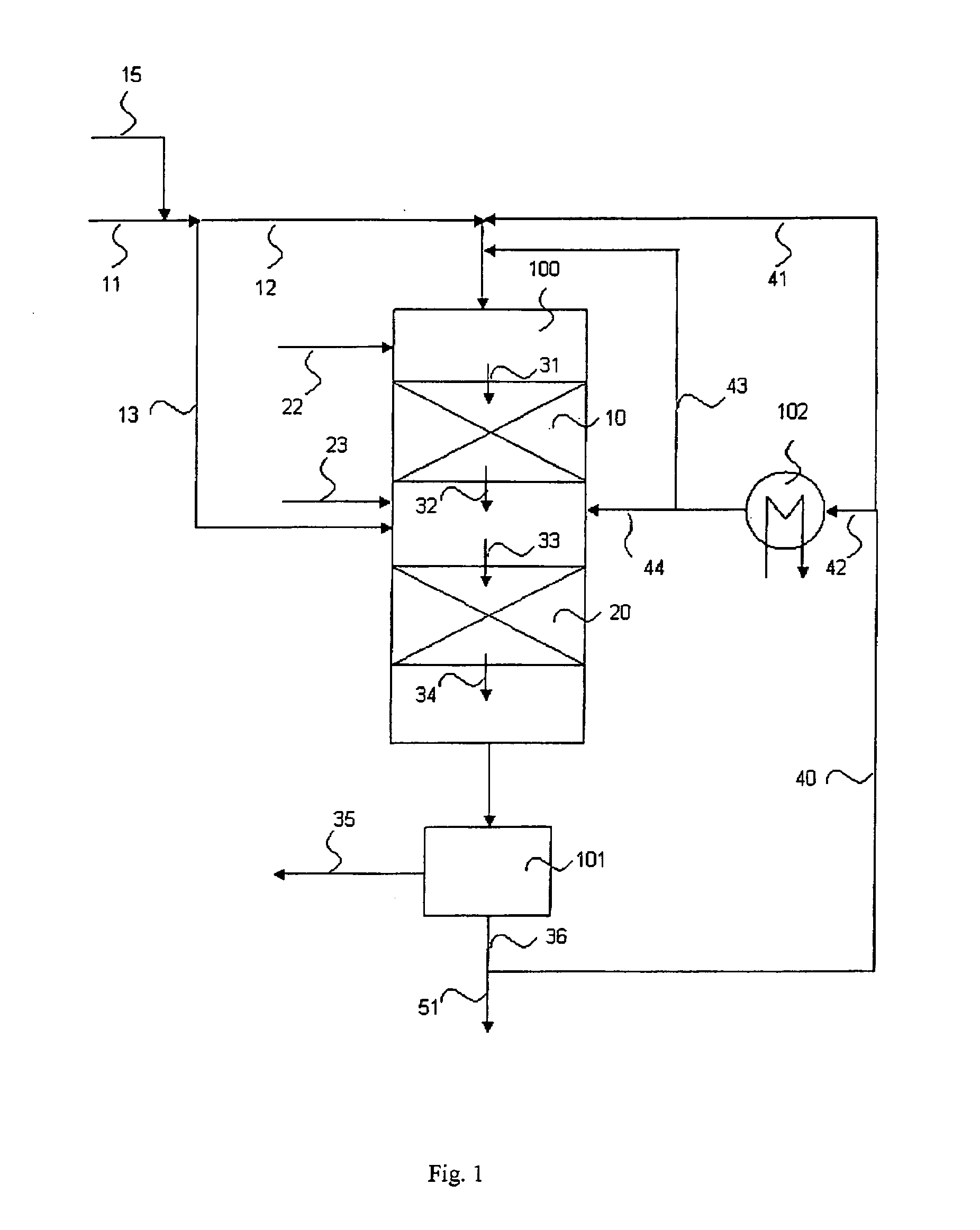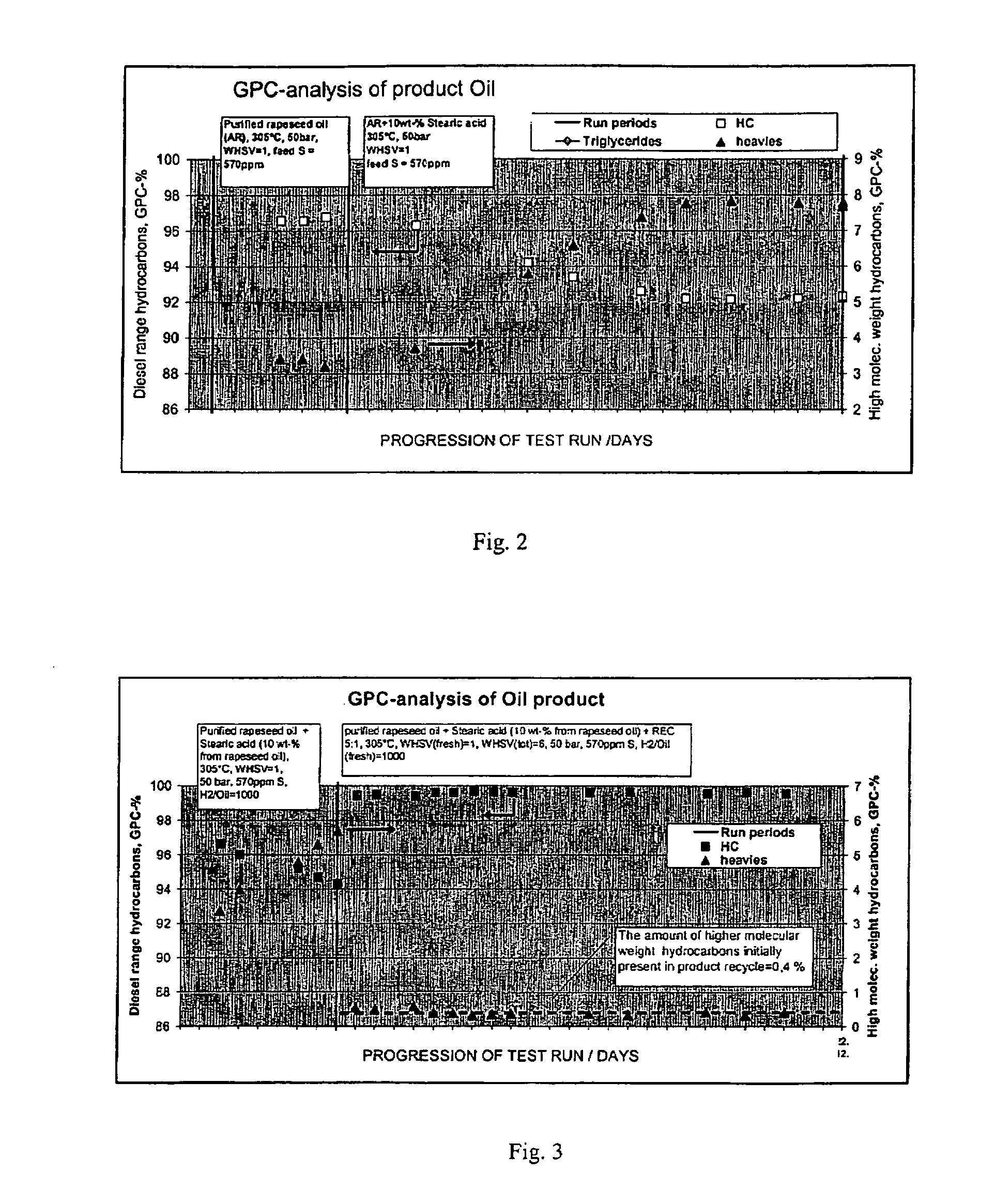Process for the manufacture of diesel range hydrocarbons
a hydrocarbon and diesel technology, applied in the field of hydrocarbon oil production process, can solve the problems of poor low-temperature properties of fame, limited use of transportation fuels, inferior properties of fatty oils, etc., and achieve the effects of reducing the formation of higher molecular weight compounds, reducing the operation temperature, and reducing the extent of side reactions
- Summary
- Abstract
- Description
- Claims
- Application Information
AI Technical Summary
Problems solved by technology
Method used
Image
Examples
example 5
Effect of Product Recycle on Preventing Formation of Unwanted Heavy Side Reaction Compounds when the Feed Contained 10 wt-% Free Fatty Acids
[0084] A hydrotreatment test run was carried out using 10 wt-% stearic acid containing purified rapeseed oil as reference feed without product recycle under following reaction conditions: WHSV=1, 50 bars, 305° C., H2 / oil-ratio=1000 and sulphur content of feed=570 ppm. During the second hydrotreatment test run period same feed was diluted with product hydrocarbons so that (fresh oil ) / (product recycle)−ratio was 1:5. WHSV of fresh oil was maintained at 1, therefore WHSV of total oil feed increased to 6. The reaction temperature was kept at 305° C. and reaction pressure at 50 bars. H2 / (fresh oil)-ratio was maintained at 1000. HDO product (n-paraffins) simulated product recycle, which was mixed in advance with fresh oil. The initial content of heavy hydrocarbons in the recycle was ˜0.4 wt-%.
[0085] It was unexpectedly observed that the formation ...
example 7
Stability of Catalyst
[0088] The stability of NiMo-catalyst using palm oil model feed (impurities added) along with product recycle (catalyst life test) was carried out using following reaction conditions: Reaction temperature=300-305° C., Reactor pressure=40 bars, WHSV (fresh)=0.5, WHSV (total)=3, H2 / Oil (fresh)=900, Sulphur in feed=100 w-ppm. Palm oil was used as a main component of feed, but it was modified with animal fat, fractions of free fatty acids, crude rapeseed oil, and lecithin in order to get suitable specification of impurities of test feed. Fresh feed analysis is presented below in table 4. Fresh oil was then diluted in advance with 1:5 ratio of HDO product (simulates product recycle). The duration of test run was over 9 months. Stabile operation was maintained (table 4 and FIG. 7) and the formation of heavies was steady over the whole test run FIG. 7.
TABLE 4Stability of catalystProduct oil analysisRun durationFresh Feed383189834085601AnalysisMethodUnitanalysishour...
PUM
| Property | Measurement | Unit |
|---|---|---|
| temperature | aaaaa | aaaaa |
| reaction temperature | aaaaa | aaaaa |
| reaction temperature | aaaaa | aaaaa |
Abstract
Description
Claims
Application Information
 Login to View More
Login to View More - R&D
- Intellectual Property
- Life Sciences
- Materials
- Tech Scout
- Unparalleled Data Quality
- Higher Quality Content
- 60% Fewer Hallucinations
Browse by: Latest US Patents, China's latest patents, Technical Efficacy Thesaurus, Application Domain, Technology Topic, Popular Technical Reports.
© 2025 PatSnap. All rights reserved.Legal|Privacy policy|Modern Slavery Act Transparency Statement|Sitemap|About US| Contact US: help@patsnap.com



